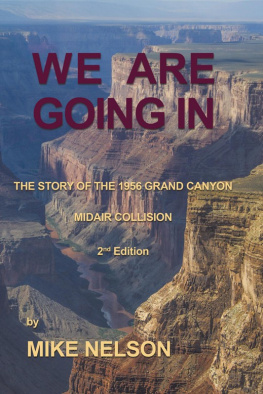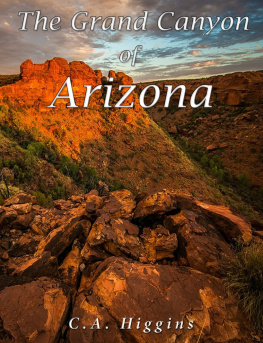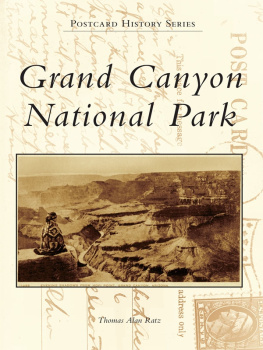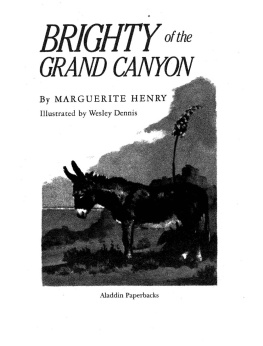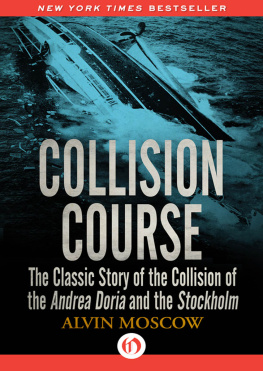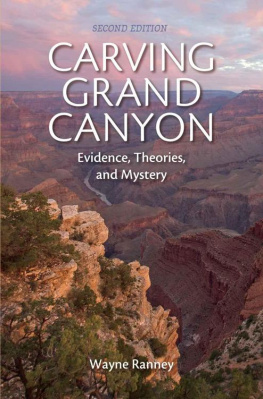WE ARE
GOING IN
THE STORY OF THE 1956 GRAND CANYON MIDAIR COLLISION
2nd Edition
BY
MIKE NELSON
With illustrations by the author
Cover photo by Wayne Ranney

AuthorHouse
1663 Liberty Drive
Bloomington, IN 47403
www.authorhouse.com
Phone: 1-800-839-8640
Mike Nelson
www.wearegoingin.com
2012 by Mike Nelson. All rights reserved.
No part of this book may be reproduced, stored in a retrieval system, or transmitted by any means without the written permission of the author.
Published by AuthorHouse 04/20/2016
ISBN: 978-1-4685-5636-0 (sc)
ISBN: 978-1-4685-5638-4 (hc)
ISBN: 978-1-4685-5637-7 (e)
Library of Congress Control Number: 2012903377
Because of the dynamic nature of the Internet, any web addresses or links contained in this book may have changed since publication and may no longer be valid. The views expressed in this work are solely those of the author and do not necessarily reflect the views of the publisher, and the publisher hereby disclaims any responsibility for them.
Acknowledgements
The work of a great many authors was invaluable in the preparation of this book, and each of them could appropriately be thanked in this section, but I have left that as implied in the Table of Resources, which cites many of them and their work.
In this list of acknowledgements I wanted to mention only those persons with whom I was actually involved, whether by correspondence, by telephone, or face-to-face. People were generally far more helpful than the work left in an archive or a library by someone I never met or spoke to, or even wrote to. I learned a lot more by communicating with people than by reading their inanimate work, which can neither listen nor respond, and can never offer anything of its own accord. The people themselves were creative, spontaneous and insightful, and in interacting with them I learned by collaboration; nearly always, the topics turned in directions I could never have anticipated, and I honestly have to credit at least half of this books content to that serendipity.
More than anyone else I want to thank Captain Robert C. Sherman, who was a captain with TWA at the time of the accident, and worked in several capacities for TWAs retired pilots association, TARPA, for many years after his retirement as an airline pilot. He had a tremendous fund of knowledge, based in a lifetime of paying attention and learning; he also had a terrific memory. Captain Sherman stuck with me for years, from nearly the beginning of this project, and he was always enthused and glad to be of help, no matter how frequently I spoke with him and no matter how rudimentary or repetitious my questions may sometimes have been. He also never balked at the difficult questions I asked him, and he took them on as exciting challenges to ponder or research. The captains explanations were lucid, his wit was sharp, and he had a knack for cutting through confusion or complexity to the heart or the essence of an issue, often helping me to clarify my questions as much as to answer them. The debt I owe him I have no idea how to measure, and my gratitude is equally difficult to try delineating. Maybe this will suffice to address both of those: it has been a privilege to know him.
Second to no one but Captain Sherman, I want to thank L. David Lewis, who contended personally with the aftermath of the disaster, and who was the first man to reach the practically inaccessible United crash site, after many experts had for many days been convinced it was impossible. Mr. Lewis is responsible for most of my understanding of what was done to retrieve the victims remains, a phenomenal feat by any standard. As a mountaineer and life-long physicist, his insights and incisive intellect gave me an exceedingly clear picture of the problems and dangers entailed in that great humanitarian effort. And like Captain Sherman, Mr. Lewis memory was excellent.
The third-most helpful person was Captain Jasper Solomon, a TWA pilot who worked at the TWA crash site. He gave me countless hours of his time, in numerous phone calls, and welcomed me into his summer home in Minnesota. Captain Solomon taught me as much about how airplanes work as anyone, especially the Lockheed Constellations. I also credit Captain Solomon with getting me started. He was there in the early days of my work on this book, bolstering my confidence that I could grasp the complexities of flight and of air traffic control rules, when I might well have come to the opinion that it was too much for a lay person to truly absorb. He always seemed to be sure that I could understand him, at least ultimately, and never tired of my questions; I am grateful to him for his support.
Quite a few younger people, who were children at the time of the accident or had yet to be born, were also instrumental in the creation of this book. Some of them provided extremely valuable records, which I could scarcely believe still existed. Also, a great many other people from the generation that dealt with the accident helped with insights or information, or references to others who helped in turn. Often what they gave me and modestly regarded as minor, turned out to be of major importance or value, but the overriding things that tied nearly all of them together were their friendliness, their willingness or enthusiasm to help, and their readiness to trust me, a complete stranger with nothing but the name of a friend to introduce himself to them, and in many cases not even that one name. They were a pleasure to work with and I wish I could have known them better. The following is a list of most of them, with their credentials given as they stood at the time of the accident, where applicable, unless specifically stated to be more current.
Ralph Anglea, air traffic controller at Oakland, involved in CAB rule making, and later, FAA rule making.
Milo Bacon, United Air Lines captain, knew Captain Shirley, flew with Harms and Fiore.
Ken Barmore, United Air Lines crew scheduler at Los Angeles International Airport.
Louis Barr, TWA flight engineer.
Edward G. Betts, TWA captain and later, unofficial historian for TARPA.
P.K. Bonde, United Air Lines captain, flew with Captain Shirley.
Ralph Breyfogle, United Air Lines copilot and later captain, brother of Forrest Breyfogle.
Hal Bryan, United Air Lines captain.
James Casteel, United Air Lines crew scheduler at Los Angeles International Airport.
George Cearley, Jr., airline historian and author some years after the tragedy.
William Cordell, TWA captain, attended flight training school with James Ritner.
Dick Cosgrave, United Air Lines captain, helped Mrs. Harms to face the reality.
Larry De Celles, TWA captain, accident investigator, later ALPA National Safety Chairman.
Ed Delaney, Chief of Dispatch with United Air Lines at Los Angeles International Airport.
Adrian Delfino, United Air Lines Corporate Historian.
Marge Dixon, United Air Lines stewardess.
William E. Dunkle, United Air Lines captain, author, knew Harms and Shirley.
Maggie Eiseman, river rafting guide, was at the scene at Chuar Butte a few days after the accident.
Clem Ellington, United Air Lines captain, knew Girardo Fiore well.
Stephan Fusco, United Air Lines captain, good friend of Robert Harms.
Harry Gann, Douglas Aircraft Company Historian.
Marge (Harms) Gibson, widow of Robert Harms, provided very moving descriptions of what she went through at the time.
Bud Gimple, United Air Lines copilot, later captain.
Morel Guyot, United Air Lines captain, flew DC-3 transport missions for canyon operations.
Next page
